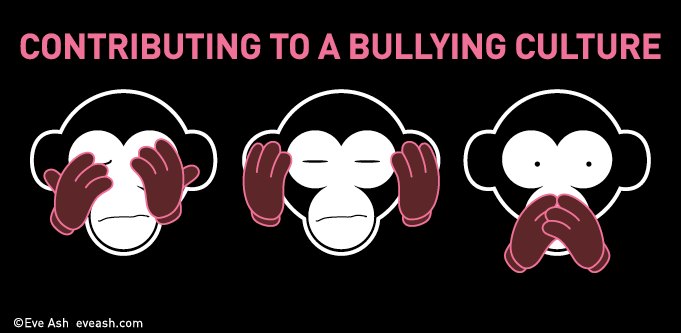We continually read about claims from victims of bullying in their workplace, or whistleblowers who report oppressive workplace cultures that condone bullying and discrimination.
Bullying alive and unwell
Not everyone is sure of what constitutes bullying, sometimes being too quick or slow to label behaviours that ultimately pose health and safety risks, costing companies millions every year through lost productivity. It’s essential in the first instance to know that workplace bullying is a clear sign of incompetent management. Bullying tends to thrive in a vacuum. That is, a vacuum caused by management failing to observe a proper duty of care to their staff and to model positive behaviours that go beyond “doing no harm” into the realm of how everyone is treated.
The problem with three wise monkeys
It’s amazing how many companies (and institutions) have a “zero tolerance” approach to bullying, yet resemble the three wise monkeys. The monkeys could “see no evil, hear no evil” and they certainly spoke “no evil”. In companies where bullying occurs, this really constitutes the bulk of the problem.
Here’s three steps to build an anti-bullying culture at work.
1. See what’s going on and recognise bullying
Bullying is fairly easy to recognise as it constitutes repeated harassment (physical or psychological), exclusion, and setting unreasonable expectations and parameters (so that a person will fail). In the recent horror story concerning the traumatising of a 16-year-old apprentice, the manager unconscionably allowed his workers to bully the youth, and indeed joined in. The company copped a fine, but the youth may be experiencing severe psychological damage that could last many years. It is bad enough when management looks the other way, but jumping in for good measure takes workplace bullying to new lows.
Check for a discernibly caring, engaged, aware and positive atmosphere in an office; it’s not too hard to notice when staff are unhappy. Look too for posturing leaders who profess much and do little – some have sour deputies, which is a big giveaway. Toxic cultures are noticeable for double standards and silent (miserable) staff who go through the motions.
2. Listen for patterns of bullying
If hurt is perceived, then it’s been received; though granted, things can get lost in translation. There’s no mistaking a pack in action – they’re in lynch-mode, chiming in, converging on (usually) one or a minority of people. It’s fairly easily spotted in cyber-bullying – the stridency of people’s interactions can’t be missed – but may be less obvious when (for example) a performance review is being conducted between two people. A recent survey of law firms found that the bulk of complaints about bullying arose from performance reviews that consisted of supervisors’ blunt or tactless assessments.
Not every upset or rude remark constitutes bullying! Some people are unaware they may be abrupt, graceless or crass. If this is what you hear, they need feedback. On the other hand, some staff who are hyper-sensitive and bristle at the most banal remarks may require a private discussion to clear things up.
3. Speak up if you are aware of a bullying
Bystanders are often reluctant to verbally wade in when a bully is having a go at someone. It takes courage to defend an outsider / victim but silence may be construed as condoning the practice. It is noticeable when nothing is said. Moreover, it’s no good having some employees or management chortling over “political correctness” (while reserving the right to be judgmental themselves) or defending the need for “robust” discussions or unsolicited comments when others are continually experiencing offence or hurt.
For example, inviting people to video-record their thoughts for management is not the way to a happy, consultative work environment. Few will, rightly, welcome the candid camera approach to airing their concerns. Instead, leaders must play their part by spear-heading restorative discussions between themselves and staff, remembering first that some training and the involvement of expert practitioners is a good starting point – otherwise you add insight to injury when inviting affected parties to air grievances.
Tips for less assertive staff to improve their emotional boundaries
- Don’t put yourself down; instead recognise your own worth.
- Don’t give in all the time; instead be assertive and proud.
- Don’t lapse into negativity; instead move forward by caring for yourself.
- Don’t stop learning and developing; instead unlock your potential.
Tips for those with domineering personalities
- Don’t block self-awareness; instead understand your feelings and biases.
- Don’t be moody or over-react; instead manage your emotions.
- Don’t be insensitive; instead care about how others feel.
- Don’t withdraw; instead communicate and connect with people.
- Don’t be someone protesting the “right” not to “tread on eggshells” with staff; instead handle the eggs with care. Accountabilities need to be clearly in place for all to see, but also the expectations of a civil and civilised environment for people to carry out their work, feeling valued and safe.

